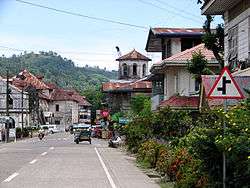Loboc, Bohol
| Loboc | |
|---|---|
| Municipality | |
|
Poblacion, Loboc | |
| Nickname(s): Music Capital of Bohol | |
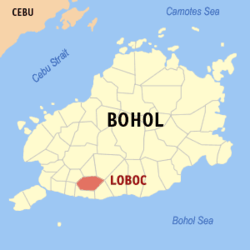 Map of Bohol with Loboc highlighted | |
.svg.png) Loboc Location within the Philippines | |
| Coordinates: 9°38′N 124°02′E / 9.63°N 124.03°ECoordinates: 9°38′N 124°02′E / 9.63°N 124.03°E | |
| Country | Philippines |
| Region | Central Visayas (Region VII) |
| Province | Bohol |
| District | 3rd district of Bohol |
| Established | 1602 |
| Barangay | 28 (see § Barangays) |
| Government [1] | |
| • Type | Sangguniang Bayan |
| • Mayor | Helen Alaba (LP) |
| • Vice mayor | Pablio Sumampong |
| • Town Council |
Members
|
| • Representative | Arthur Yap |
| Area[2] | |
| • Total | 57.65 km2 (22.26 sq mi) |
| Population (2015 census)[3] | |
| • Total | 15,993 |
| • Density | 280/km2 (720/sq mi) |
| • Voter (2016)[4] | 11,472 |
| Time zone | PST (UTC+8) |
| ZIP code | 6316 |
| IDD : area code | +63 (0)38 |
| Income class | 4th class |
| PSGC | 071229000 |
| Website |
www |
Loboc is a 4th municipal income class municipality in the province of Bohol, Philippines. It is 25 kilometres (16 mi) east of Tagbilaran. According to the 2015 census, it has a population of 15,993.[3] In the 2016 election, it had 11,472 registered voters.[4]
Loboc is known for its lunch cruises along the scenic and winding Loboc River. Tourists also come to see the tarsier, a small nocturnal animal with large red eyes. It is one of the world's smallest primates. The Loboc Children's Choir has won numerous competitions both domestic and international.
Until the 2013 earthquake portions of the Loboc Church complex (specifically parts of what became the convent or priests' residence) were amongst the oldest standing ecclesiastical structures in Bohol province. The earthquake also damaged the lunch cruise Docking Port, and some damage to the pedestrian river bridge and its passenger elevator.[lower-alpha 1]
At the end of 2014, Tropical storm Seniang passed directly over the Loboc river area. Although the winds were relatively low strength, Seniang brought with it a lot of rainfall. This caused the river to burst its banks in several places: the entire poblacion main plaza was flooded, including the town hall; many of the lunch cruise boats were damaged; and the accumulated debris of the church was disturbed and some washed away. It was fortunate that the new replacement bridge across the river had been completed just a few weeks before, allowing traffic to reach Tagbilaran via Sikatuna because the Loay interior road was damaged and impassable.[6][7]
History
Since pre-Hispanic times, Loboc has always been an inland market village where produce from the sea was bartered for the agricultural goods of the upland regions. It is said to be the domain of Sigala, another chief of Bohol, whose contemporary, Sikatuna, made the famous Blood Compact with Miguel López de Legazpi in 1565.
In 1596, the Jesuit Fr Juan de Torres came to Loboc from Baclayon to found the second Christian settlement on the island. After the traumatic Moro raid on Baclayon on 26 October 1600, the Jesuit missionaries decided to move the center of their missionary activities to the inland village of Loboc. By 1602, Loboc became a parish, making it the oldest on the island. To the Jesuits, Loboc was the "Residencia Boholana", where their local superior resided. It remained so until the middle of the 18th century when the exigencies of the times forced to them to move once more to Baclayon.
Around 1604, the Jesuits established a "Seminario-Colegio" or boarding school for native boys. This school laid the foundation of the musical culture of the town. Today the name Loboc is synonymous with musical acumen.
The Loboc Church is one of the most beautiful in the entire province. The first stone church was built in 1602. It was destroyed by fire in 1638 and its replacement built beside the site of the older one. This is the church presently standing, a fine example of the Jesuit colonial architecture of the 18th century.
After the expulsion of the Jesuits in 1768, the Augustinian Recollects took over and renovated the unfinished structure. They were responsible for the free-standing bell tower, the arcade façade, the mortuary chapel, the heavy stone buttresses and the unique three-storey convent built into the fabric of the Jesuit-built 17th century church.
Two saintly figures lived and were buried in Loboc church: Fr Alonso Humanes SJ whose grave became the object of pilgrimages after his death in 1633, and the native boy, Miguel Ayatumo, a student of the Seminario Colegio, who died in the odor of sanctity at the age of sixteen in 1609. Contemporary Jesuit records speak glowingly of this "Aloysius Gonzaga" of Bohol.
Loboc Church contains a lot of interesting treasures. Among these are the decorative stone carvings and friezes on the exterior walls; a relief of St. Ignatius Loyola in polychrome stucco hidden behind the main altar, seven ancient retablos from both the Jesuit and Recollect periods; ceiling murals executed in the 1920s by Cebuano artists Ray Francia and Canuto Avila, one depicting the miracle of Our Lady of Guadalupe, the town's secondary patron, during the great flood of 1876; carved wooden cornices and decorative corbels shaped as gargoyles or mythical animals.
Much of the early history of Bohol was made around the town and church of Loboc. It would not be an understatement to say that to know Loboc is to understand the entire drama of Bohol history. At present, Loboc church is deteriorating, ignored by tourists and visitors and continually threatened by the annual flood that has already robbed it of its ancient records and other priceless relics. The church was severely damaged by the 2013 Bohol earthquake, and the tropical storm Seniang at the end of 2014 washed away most of the remains waiting for repair.
In 1942 Japanese troops occupied Loboc. In 1945, Loboc was liberated by the Philippine Commonwealth Army troops of the 81st & 83rd Infantry Division together with the Boholano guerrillas at the end in World War II.
Barangays
Loboc comprises 28 barangays:
| PSGC | Barangay | Population | ±% p.a. | ||
|---|---|---|---|---|---|
| 2015[3] | 2010[8] | ||||
| 071229001 | Agape | 3.6% | 579 | 660 | −2.46% |
| 071229002 | Alegria | 3.7% | 586 | 571 | +0.49% |
| 071229003 | Bagumbayan | 3.8% | 610 | 684 | −2.16% |
| 071229004 | Bahi‑an | 3.1% | 503 | 519 | −0.59% |
| 071229005 | Bonbon Lower | 1.5% | 235 | 218 | +1.44% |
| 071229006 | Bonbon Upper | 3.9% | 631 | 584 | +1.48% |
| 071229007 | Buenavista | 2.1% | 334 | 280 | +3.41% |
| 071229008 | Bugho | 3.5% | 565 | 572 | −0.23% |
| 071229009 | Cabadiangan | 1.6% | 260 | 276 | −1.13% |
| 071229010 | Calunasan Norte | 4.2% | 674 | 631 | +1.26% |
| 071229011 | Calunasan Sur | 2.5% | 392 | 406 | −0.67% |
| 071229012 | Camayaan | 6.3% | 1,011 | 1,039 | −0.52% |
| 071229013 | Cambance | 1.9% | 307 | 346 | −2.25% |
| 071229014 | Candabong | 4.6% | 728 | 736 | −0.21% |
| 071229015 | Candasag | 1.3% | 211 | 254 | −3.47% |
| 071229016 | Canlasid | 1.8% | 295 | 250 | +3.20% |
| 071229017 | Gon‑ob | 1.7% | 271 | 285 | −0.95% |
| 071229018 | Gotozon | 5.4% | 870 | 771 | +2.33% |
| 071229019 | Jimilian | 7.3% | 1,170 | 1,211 | −0.65% |
| 071229020 | Oy | 8.1% | 1,302 | 1,387 | −1.20% |
| 071229021 | Poblacion Sawang | 3.7% | 598 | 671 | −2.17% |
| 071229022 | Poblacion Ondol | 5.0% | 796 | 802 | −0.14% |
| 071229023 | Quinoguitan | 3.1% | 502 | 488 | +0.54% |
| 071229024 | Taytay | 1.5% | 245 | 259 | −1.05% |
| 071229025 | Tigbao | 5.2% | 826 | 867 | −0.92% |
| 071229026 | Ugpong | 2.1% | 335 | 332 | +0.17% |
| 071229027 | Valladolid | 2.8% | 445 | 478 | −1.35% |
| 071229028 | Villaflor | 4.5% | 712 | 735 | −0.60% |
| Total | 15,993 | 16,312 | −0.38% | ||
Demographics
| Population census of Loboc | |||||||||||||||||||||||||
|---|---|---|---|---|---|---|---|---|---|---|---|---|---|---|---|---|---|---|---|---|---|---|---|---|---|
|
| ||||||||||||||||||||||||
| Source: Philippine Statistics Office[3][8][9] | |||||||||||||||||||||||||
In the 2016 election, it had 11,472 registered voters, meaning that 72% of the population are aged 18 and over.[4]
Gallery
 Poblacion and municipal hall
Poblacion and municipal hall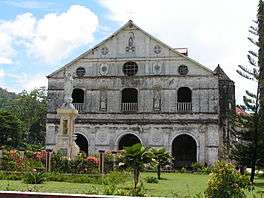 Loboc Church
Loboc Church Remains of Loboc church post-2013 earthquake
Remains of Loboc church post-2013 earthquake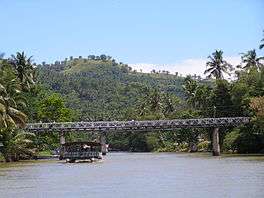 Loboc River Cruise
Loboc River Cruise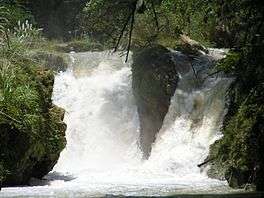 Busay Falls on Loboc river
Busay Falls on Loboc river
Notes
References
- ↑ "Municipality". Quezon City, Philippines: Department of the Interior and Local Government. Retrieved 31 May 2013.
- ↑ "Municipal: Loboc, Bohol". PSGC Interactive. Quezon City, Philippines: Philippine Statistics Authority. Retrieved 8 January 2016.
- 1 2 3 4 "Region VII (CENTRAL VISAYAS)". Census of Population (2015): Total Population by Province, City, Municipality and Barangay (Report). PSA. Retrieved 20 June 2016.
- 1 2 3 "2016 National and Local Elections Statistics". Commission on Elections. 2016.
- ↑ The Freeman, Liv Campo and Wenna A. Berondo (9 September 2005). "Santiago inspects unfinished bridge in Loboc, Bohol". Archived from the original on 1 July 2015. Retrieved 12 July 2016.
- ↑ "'Unprecedented' floods in Bohol as Seniang kills 11". rappler.com. 30 December 2014. Retrieved 6 February 2015.
- ↑ ""Seniang" places Bohol under state of calamity". Bohol News Today. 31 December 2014. Retrieved 6 February 2015.
- 1 2 "Region VII (CENTRAL VISAYAS)". Census of Population and Housing (2010): Total Population by Province, City, Municipality and Barangay (Report). NSO. Retrieved 29 June 2016.
- ↑ "Region VII (CENTRAL VISAYAS)". Census of Population (1995, 2000 and 2007): Total Population by Province, City and Municipality (Report). NSO. Archived from the original on 24 June 2011.
External links
| Wikimedia Commons has media related to Loboc. |
 |
Sevilla | Bilar |  | |
| Sikatuna | |
|||
| ||||
| | ||||
| Alburquerque | Loay | Lila |
